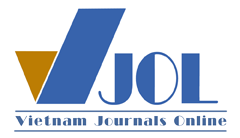Study on synthesis of Metal-organic Framework ZIF-67 and Its application as an absorbent for Remazol Deep Black (RDB) removal from aqueous media
DOI:
https://doi.org/10.51316/jca.2021.006Keywords:
MOFs, ZIF-67, adsorption, microwave, RDBAbstract
In this work, zeolitic imidazolate framework-67(ZIF-67) was synthesized by using microwave-assisted method. The obtained ZIF-67 was characterized by means of scanning electron microscope (SEM), X-ray diffraction (XRD), and thermal gravity analysis (TG). The microwave-assisted method enabled to fabricate ZIF-67 with high yield rate and high specific surface areas of 1935 m2/g in relatively short time as compared to hydrothermal and solvothermal approaches. The Langmuir and Freundlich isotherm models were utilized to determine the adsorption capacity of ZIF-67. It was found that the adsorption capacity of ZIF-67 for RDB could be as high as 123,5 mg/g.
Downloads
References
M.P. Suh, H.J. Park, T.K. Prasad, D.-W. Lim, Chemical reviews, 112 (2012) 782-835. https://doi.org/10.1021/cr200274s
J. Lee, O.K. Farha, J. Roberts, K.A. Scheidt, S.T. Nguyen, J.T. Hupp, Chemical Society Reviews, 38 (2009) 1450-1459. https://doi.org/10.1039/B807080F
L.E. Kreno, K. Leong, O.K. Farha, M. Allendorf, R.P. Van Duyne, J.T. Hupp, Chemical reviews, 112 (2012) 1105-1125. https://doi.org/10.1021/cr200324t
D. Farrusseng, S. Aguado, C. Pinel, Angewandte Chemie International Edition, 48 (2009) 7502-7513. https://doi.org/10.1002/anie.200806063
J. Qian, F. Sun, L. Qin, Materials Letters, 82 (2012) 220-223. https://doi.org/10.1016/j.matlet.2012.05.077
A.F. Gross, E. Sherman, J.J. Vajo, Dalton transactions, 41 (2012) 5458-5460. https://doi.org/10.1039/C2DT30174A
E.-X. Chen, H. Yang, J. Zhang, Inorganic chemistry, 53 (2014) 5411-5413.
https://doi.org/10.1021/ic500474j
K.-Y.A. Lin, H.-A. Chang, Journal of the Taiwan Institute of Chemical Engineers, 53 (2015) 40-45. ttps://doi.org/10.1016/j.jtice.2015.02.027
H. Zhang, J. Zhong, G. Zhou, J. Wu, Z. Yang, X. Shi, Journal of Nanomaterials, 2016 (2016). https://doi.org/10.1021/jacs.8b13889
M. Wang, X. Jiang, J. Liu, H. Guo, C. Liu, Electrochimica Acta, 182 (2015) 613-620. https://doi.org/10.1016/j.electacta.2015.08.116
Y. Li, K. Zhou, M. He, J. Yao, Microporous and Mesoporous Materials, 234 (2016) 287-292. https://doi.org/10.1016/j.micromeso.2016.07.039
C.R. Groom, I.J. Bruno, M.P. Lightfoot, S.C. Ward, Acta Crystallographica Section B: Structural Science, Crystal Engineering and Materials, 72 (2016) 171-179. https://doi.org/10.1107/S2052520616003954
N.A. Khan, B.K. Jung, Z. Hasan, S.H. Jhung, Journal of Hazardous Materials, 282 (2015) 194-200. https://doi.org/10.1016/j.jhazmat.2014.03.047
B.K. Jung, J.W. Jun, Z. Hasan, S.H. Jhung, Chemical Engineering Journal, 267 (2015) 9-15. https://doi.org/10.1016/j.cej.2014.12.093
M. Fathi, A. Asfaram, A. Farhangi, Spectrochimica Acta Part A: Molecular and Biomolecular Spectroscopy, 135 (2015) 364-372. https://doi.org/10.1016/j.saa.2014.07.008
I. Langmuir, Journal of the American chemical society, 38 (1916) 2221-2295. https://doi.org/10.1021/ja02268a002
[17]. A. Asfaram, M. Ghaedi, S. Hajati, A. Goudarzi, E.A. Dil, Ultrasonics sonochemistry, 34 (2017) 1-12. https://doi.org/10.1016/j.ultsonch.2016.05.011
H. Freundlich, J. Phys. Chem, 57 (1906) 1100-1107.
S.-C. Ma, J.-L. Zhang, D.-H. Sun, G.-X. Liu, Applied Surface Science, 359 (2015) 48-54. https://doi.org/10.1016/j.apsusc.2015.09.133
M.T. Thanh, T.V. Thien, P.D. Du, N.P. Hung, D.Q. Khieu, Journal of Porous Materials, 25 (2018) 857-869. https://doi.org/10.1007/s10934-017-0498-7
N.F. Cardoso, R.B. Pinto, E.C. Lima, T. Calvete, C.V. Amavisca, B. Royer, M.L. Cunha, T.H. Fernandes, I.S. Pinto, Desalination, 269 (2011) 92-103. https://doi.org/10.1016/j.desal.2010.10.047
V. Ranjusha, R. Pundir, K. Kumar, M. Dastidar, T. Sreekrishnan, Journal of environmental science and health Part A, 45 (2010) 1256-1263. https://doi.org/10.1080/10934529.2010.493812.











